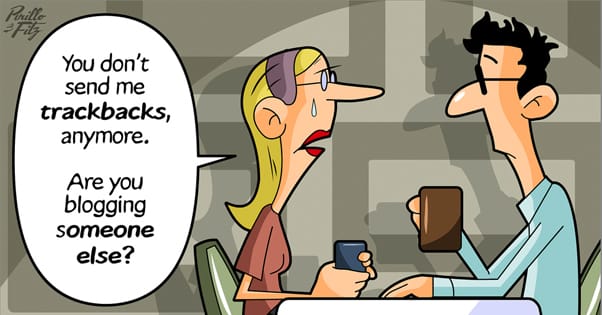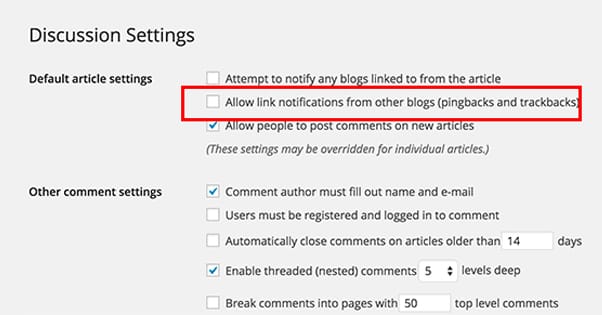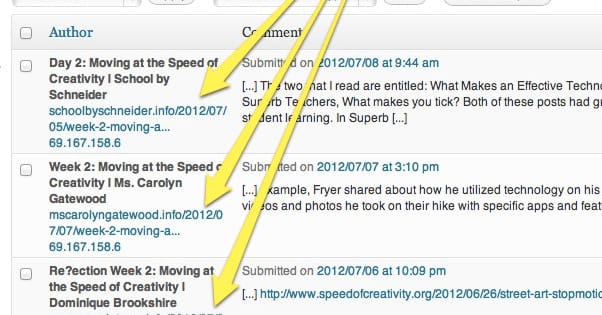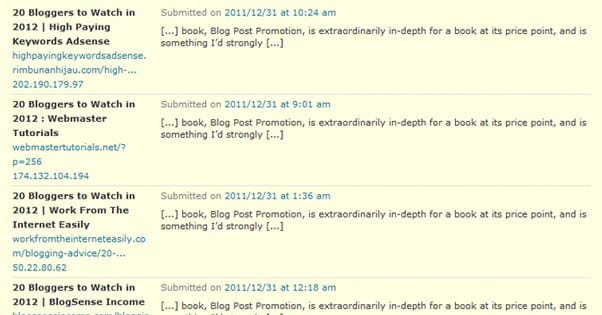Should I Approve New WordPress Pingbacks & Trackbacks?
Published by James Parsons • Search Engine Optimization • Posted November 25, 2015 ContentPowered.com
ContentPowered.com
Pingbacks and Trackbacks in WordPress are a very interesting idea. Unfortunately, they were very interesting to spammers as well, and those spammers very quickly took over using them for malicious purpose. From then on, the debate raged; are they valuable? Should you approve them? Can you safely delete them? Is there a way to make them valuable again? Let’s take a look.
What are Trackbacks and Pingbacks?
Trackbacks are a funny sort of communication between bloggers. Essentially, the process looks like this. You write a blog post. Another blogger wants to comment, but they want their readers to see that comment on their blog, without having to go to yours. They write a blog post as a response, and submit it as a trackback to your blog post.
Now you have an option. Do you want to approve the trackback or not? If you do, it will appear on your blog as a comment. That comment will have the title of their blog post, a short excerpt, and a link to that post. The conversation via comments thus diverges; some people comment on your post, some people comment on theirs, and now there are two conversations instead of one.
There are both benefits and drawbacks to this, but I’ll get to them later. What about Pingbacks?
A Pingback is somewhat similar. You write a blog post, and someone else wants to mention it. They decide to link to your post and mention it in their post. This triggers WordPress to send a Pingback to your WordPress, which will go confirm that the link actually exists and comes from the URL it claims to come from.
Once this verification happens, you are given the chance to display the Pingback or not. If you do, it displays as a link in your comments, to the site that linked to you. This is one-way, but because it triggers upon receiving a link to your site, it essentially just makes a link reciprocal.
Pingbacks do not send content beyond the existence of the link. Trackbacks send more content, like the excerpt mentioned. One awful thing about Pingbacks, though, is that they trigger on any link from another WordPress or Pingback-enabled CMS. That means that if you link to one of your own blog posts, from one of your own blog posts, you get an internal Pingback. Given that internal linking is an important part of SEO, this can get very disruptive for no tangible benefit.
Moderating, Disabling, and Plugin Managing
Moderating Trackbacks and Pingbacks through WordPress by default is very easy. All you need to do is go to the comment moderation section of your dashboard. This is where you will discover that, for the most part, the majority of your Trackbacks and Pingbacks will be spam.
Why is this? It’s because they’re automatic, and a lot of bloggers don’t moderate or disable them. So when a spammer links to your site in a footer or a thin blog post, the Pingback suddenly creates a link to their spam site. This hurts you twice over; once because there’s an incoming spam link, and once because you’re linking back. Even if your site is legitimate, this will drag it down while temporarily benefitting the spammer.
You will also receive Pingbacks from sites that use WordPress to copy your content. Any post of yours that includes a link to another post of yours will create a Pingback when a content thief copies it wholesale and doesn’t strip out the links.
Trackbacks are a little less spammy in an automatic sense, because the spammer has to actually implement one to get it into the system. It’s not something that’s done as a side effect of a content scraper bot. That’s not much better, though.
In the comments moderation menu, you will see all of your pending Trackbacks and Pingbacks, as well as all of the existing, published Trackbacks and Pingbacks. From there, you can decide to remove, approve, or mark as spam any you choose.
If you would prefer to disable them entirely, all you need to do is go to the Settings menu and click Discussion. Under this section, there is an entry labeled “Allow link notifications from other blogs.” Uncheck this, and both Trackbacks and Pingbacks will be disabled across your entire blog. This will, however, only disable those actions for future posts. For existing posts, you will need to do something else, with a little more code and effort involved. If you’re comfortable working with MySQL, read on.
First, log in to your PHPMyAdmin and identify which database is your WordPress database. You will find this through your web host. Once you find the database, you will need to execute this query. Make sure it is typed exactly:
- UPDATE wp_posts SET ping_status=’closed’ WHERE post_status = ‘publish’ AND post_type = ‘post’;
- UPDATE wp_posts SET ping_status=’closed’ WHERE post_status = ‘publish’ AND post_type = ‘page’;
This will go through the database and identify all posts that are either the Post or the Page type, and are published. On all of these posts, it will change the Pingback status to closed. The ping_status entry is what both Pingbacks and Trackbacks use, so it will disable both for all existing posts of those categories. If you have custom categories you use beyond page and post, you will need to run a third line to the query changing the final post_type entry to the custom post type.
So, what if you actually like Trackbacks and Pingbacks, but don’t want to deal with the hassle of mass self-pinging caused by your own internal links? In that case, you can install this plugin, which automatically filters self pings without disabling the rest of the Pingback functionality.
The Argument For Keeping Trackbacks and Pingbacks
There are a few good reasons you might want to keep Trackbacks and Pingbacks enabled, though I will say this up front; never, ever make them auto-approve. You will end up with hundreds or thousands of spam comments on your blog, and it’s a massive pain to clean them up. Not to mention the fact that those links might earn you a bit of a Google penalty in the process.
So how can these be good for you? The first is, obviously, when they work as intended. Some high profile sites will use WordPress, including most top-end industry blogs. Getting a Pingback or Trackback from one of these sites is bound to be a beneficial link, and it’s good to be notified of when they exist and repay the favor, such as it is, with your own.
Of course, very rarely will they be working as intended. The primary benefit I’ve seen is to monitor them for content theft. When someone steals your content and saves your links, internal links will generate a Pingback automatically. You can use this to identify the site immediately and issue a takedown notice to them via Google’s DMCA integration.
You can also use this to discover newcomers in your niche who are linking to your content, which can be beneficial to you. Monitor those sites and help them along; mutual assistance can be great for everyone involved, as long as they aren’t direct competition.
Of course, you don’t have to approve any of the Trackbacks or Pingbacks you receive. There’s one school of thought that argues against it. Their argument goes something like this: an incoming link is good, but a reciprocal link can be bad, because it’s often part of what spammers do. Making every incoming link – from a WordPress blog, at least – a reciprocal link can do quite a bit of damage to your site. Use the pending notifications to identify when a link comes in, but don’t approve the Pingbacks or Trackbacks for publication. Knowledge is power.
I don’t think there’s anything quite so apocalyptic going on with them. I think the main reason most people don’t approve them or display them is because so many of them are spam. Think about it; if you have 10,000 Pingbacks to go through, and 9,999 of them are spam, is that 1 remaining legitimate Pingback worth the digging? Most people would just say no. It’s easier to ignore them than it is to dig for that minimal amount of value.
Should You Publish Pingbacks or Trackbacks?
Let’s take this in context. Trackbacks are user-initiated and one-way. They’re beneficial engagement on both your site and the originating site, in that they can spur on two conversations where there was only one before. However, this does mean you might end up having to monitor twice as many comment threads and answer the same question several times. It can also be detrimental if the originating site keeps all their engagement on their site, so you get none of it. I would say it is entirely fine to publish Trackbacks, as long as they come from reputable sites you don’t mind being associated with.
There’s nothing inherently wrong with the entire system of Trackbacks and Pingbacks in terms of SEO and Google. The reciprocal link thing isn’t dangerous unless you’re engaging in it with spam sites. Sites link to each other all the time, and even a direct 1:1 reciprocation isn’t bad when it’s not every single link on your site. Don’t worry about that aspect of things.
Trackbacks initiated by sites you don’t trust, sites that aren’t indexed, or sites that look like spam, however, should be marked as spam or at the very least ignored. Don’t publish them.
Pingbacks are a little bit trickier. First of all, you have self-pings, which are just reciprocation for internal links, and which provide no benefit to you. Don’t approve these. Ideally, you will use the plugin I linked above to disable them entirely, though it might not work on the newest installations of WordPress.
Pingbacks from sites that are reputable, on the other hand, you can approve just fine. They are minimally disruptive and they add a certain degree of authority to your posts. When someone reads a post and they’re a little skeptical, seeing that a high profile site linked to you will get them to trust you more. On the other hand, it doesn’t benefit you in terms of SEO directly; you already have the incoming link, and telling people about them isn’t that useful.
Pingbacks from sites that are disreputable or spam should be marked as spam and ignored. As I mentioned, you can also use these to detect content theft and proactively pursue action against it. However, this can easily get overwhelming, and your actions might not be all that beneficial. It’s not as though Google is going to harm you because another site copied your content.
Here’s one thing to note: no one is notified when you approve or deny a Trackback or Pingback. If you look at it and decide to remove it, that’s it, end of interaction. If you decide to approve it, it goes live, but the originating site isn’t notified. They would have to go back to your post to look and see if their Ping or Track was published. Most people don’t do this, and those who do are likely fishing for links and aren’t going to be the sort you would approve in the first place. There is absolutely no reason to not delete or mark as spam the Trackbacks and Pingbacks you don’t want to publish.
There’s only one really good argument against Trackbacks and Pingbacks as far as I’m concerned, and that’s the fact that it’s a system so very prone to abuse. Again, if you have 10,000 of these notifications to dig through, 99% of them are going to be spam. It’s time consuming to filter through them, and it’s very difficult to extract enough value from them to make it worth the time.
Rather, this is what I would do.
- Set up alerts and monitoring software to find mentions of your URL around the web.
- When you find a notification that a high profile, valuable site has mentioned or linked to you, check your notifications to see if a Trackback or Pingback was created.
- If you find such a Trackback or Pingback, feel free to approve it. Ignore the rest.
This process helps you more directly identify when a high quality site is linking to you, and it helps you eliminate the need to filter through hundreds of entries in the hopes of finding one with meager value. It also lets you be very exclusive with your Trackbacks and Pingbacks, so people fishing for links will know it’s unlikely they will be featured.
All things considered, in a better world, Trackbacks and Pingbacks would be an amazing system. As it stands, though, there’s just too much abuse and too little value to be had in it to actually let the whole thing run wild. Unfortunately, as well, it only works on WordPress. Many of the best sites out there have outgrown WordPress and have shifted to a custom framework, so you won’t get the most beneficial possible versions of those entries.









now i know – well written piece, thanks a lot
Hi James,
Good article.
I have one question?
When I use my existing blog posts link on another article then there is automatic entry of the link in the comments.
Can I directly delete it because this is increasing day by day everytime when I use any links? or should it remain as it is.
If I delete does it affect my blog.
Hi James,
Very valuable article indeed. It really helped to understand pingback.
I appreciate creating such helpful content.
Keep doing a good job.